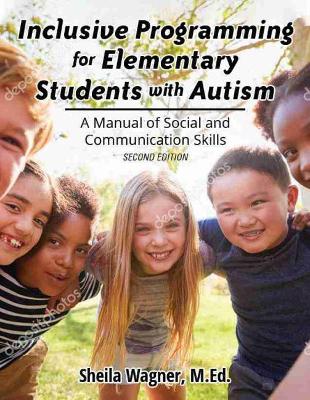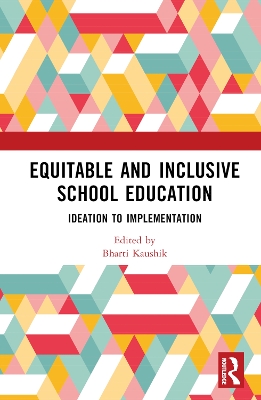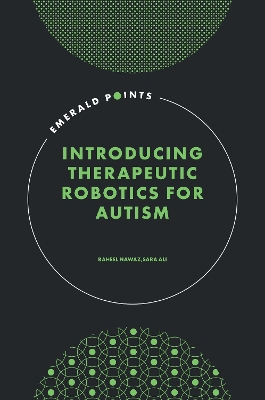Inclusive Progamming for Elementrary Students with Autism
 portes grátis
portes grátis
Inclusive Progamming for Elementrary Students with Autism
A Manual of Social and Communication Skills
Wagner, Sheila
Future Horizons Incorporated
10/2021
175
Mole
Inglês
9781949177718
15 a 20 dias
333
Descrição não disponível.
Introduction: A brief note to parents
A brief note to teachers
A word about Terminology
Epidemiology of autism
ASD & Risk Factors
Co-Morbidity
Defining the Autism Spectrum Disorder
Impaired communication
Impaired social relatedness
Presence of repetitive behaviors or rituals
Other behaviors of note
Inclusive Programming for the Student with Autism
What's the reason behind it?
Philosophical Reasoning
Benefits to the students with autism
Benefits to the typical students
Benefits of peer tutoring/social skills programming
Defining the Inclusion Process
Model for Inclusion
Inclusion philosophy
Administrative support
Teacher training
Inclusion coordinator
Collaboration of general and special education
Classroom supports
IEP Driven
General education ownership
Collaboration between home and school
Assessing the Individual student
Step one: Determine the strengths and challenges
Step two: Observe the general education classroom the child will attend
Step three: Review IEP goals and objectives
Step four: Tackling existing behavioral challenges
Step five: Determine which social skills will be targeted in the classroom
Step six: Conduct reinforcer surveys
Step seven: Set weekly or biweekly meetings with all people involved
Step eight: Conclusion
Assessing the School, Teachers and Classroom
Step one: Assess the school
Step two: Special education teacher assessment
Step three: General education teacher assessment
Step four: Support personnel assessment
Step five: Classroom assessment
Step six: Parent assessment
A word about higher-order autism
A principal's role
Staff roles
Chain of command
Teacher selection
Substitutes
Working with parents
Personal Philosophy
Suspension from school
How do we Impact Social Skills
Social Skills for the student with autism
Training typical peers for social intervention
Classroom social skills programming
The Marble Jar
The Friends Club
The Classroom Manager Role
The Lunch Bunch
Social games for elementary students
How do we impact behaviors?
Motivation and students with autism
The Rocketship Program
The Snake Race
The Puzzle Piece
Self-regulated calm down time
Addressing self-stim behaviors
Desensitization programs for students with autism
The IEP Process
How do we teach these students?
Paraprofessional support for students with autism in inclusive settings
Academic modifications for Inclusion
Taking Data in Inclusion
Collaboration between home and school
Transition planning for middle school
A parent's perspective
Contributions
A final word
References
Appendix
Author's Biography
A brief note to teachers
A word about Terminology
Epidemiology of autism
ASD & Risk Factors
Co-Morbidity
Defining the Autism Spectrum Disorder
Impaired communication
Impaired social relatedness
Presence of repetitive behaviors or rituals
Other behaviors of note
Inclusive Programming for the Student with Autism
What's the reason behind it?
Philosophical Reasoning
Benefits to the students with autism
Benefits to the typical students
Benefits of peer tutoring/social skills programming
Defining the Inclusion Process
Model for Inclusion
Inclusion philosophy
Administrative support
Teacher training
Inclusion coordinator
Collaboration of general and special education
Classroom supports
IEP Driven
General education ownership
Collaboration between home and school
Assessing the Individual student
Step one: Determine the strengths and challenges
Step two: Observe the general education classroom the child will attend
Step three: Review IEP goals and objectives
Step four: Tackling existing behavioral challenges
Step five: Determine which social skills will be targeted in the classroom
Step six: Conduct reinforcer surveys
Step seven: Set weekly or biweekly meetings with all people involved
Step eight: Conclusion
Assessing the School, Teachers and Classroom
Step one: Assess the school
Step two: Special education teacher assessment
Step three: General education teacher assessment
Step four: Support personnel assessment
Step five: Classroom assessment
Step six: Parent assessment
A word about higher-order autism
A principal's role
Staff roles
Chain of command
Teacher selection
Substitutes
Working with parents
Personal Philosophy
Suspension from school
How do we Impact Social Skills
Social Skills for the student with autism
Training typical peers for social intervention
Classroom social skills programming
The Marble Jar
The Friends Club
The Classroom Manager Role
The Lunch Bunch
Social games for elementary students
How do we impact behaviors?
Motivation and students with autism
The Rocketship Program
The Snake Race
The Puzzle Piece
Self-regulated calm down time
Addressing self-stim behaviors
Desensitization programs for students with autism
The IEP Process
How do we teach these students?
Paraprofessional support for students with autism in inclusive settings
Academic modifications for Inclusion
Taking Data in Inclusion
Collaboration between home and school
Transition planning for middle school
A parent's perspective
Contributions
A final word
References
Appendix
Author's Biography
Este título pertence ao(s) assunto(s) indicados(s). Para ver outros títulos clique no assunto desejado.
special needs; autism; inclusion; social skills; special education
Introduction: A brief note to parents
A brief note to teachers
A word about Terminology
Epidemiology of autism
ASD & Risk Factors
Co-Morbidity
Defining the Autism Spectrum Disorder
Impaired communication
Impaired social relatedness
Presence of repetitive behaviors or rituals
Other behaviors of note
Inclusive Programming for the Student with Autism
What's the reason behind it?
Philosophical Reasoning
Benefits to the students with autism
Benefits to the typical students
Benefits of peer tutoring/social skills programming
Defining the Inclusion Process
Model for Inclusion
Inclusion philosophy
Administrative support
Teacher training
Inclusion coordinator
Collaboration of general and special education
Classroom supports
IEP Driven
General education ownership
Collaboration between home and school
Assessing the Individual student
Step one: Determine the strengths and challenges
Step two: Observe the general education classroom the child will attend
Step three: Review IEP goals and objectives
Step four: Tackling existing behavioral challenges
Step five: Determine which social skills will be targeted in the classroom
Step six: Conduct reinforcer surveys
Step seven: Set weekly or biweekly meetings with all people involved
Step eight: Conclusion
Assessing the School, Teachers and Classroom
Step one: Assess the school
Step two: Special education teacher assessment
Step three: General education teacher assessment
Step four: Support personnel assessment
Step five: Classroom assessment
Step six: Parent assessment
A word about higher-order autism
A principal's role
Staff roles
Chain of command
Teacher selection
Substitutes
Working with parents
Personal Philosophy
Suspension from school
How do we Impact Social Skills
Social Skills for the student with autism
Training typical peers for social intervention
Classroom social skills programming
The Marble Jar
The Friends Club
The Classroom Manager Role
The Lunch Bunch
Social games for elementary students
How do we impact behaviors?
Motivation and students with autism
The Rocketship Program
The Snake Race
The Puzzle Piece
Self-regulated calm down time
Addressing self-stim behaviors
Desensitization programs for students with autism
The IEP Process
How do we teach these students?
Paraprofessional support for students with autism in inclusive settings
Academic modifications for Inclusion
Taking Data in Inclusion
Collaboration between home and school
Transition planning for middle school
A parent's perspective
Contributions
A final word
References
Appendix
Author's Biography
A brief note to teachers
A word about Terminology
Epidemiology of autism
ASD & Risk Factors
Co-Morbidity
Defining the Autism Spectrum Disorder
Impaired communication
Impaired social relatedness
Presence of repetitive behaviors or rituals
Other behaviors of note
Inclusive Programming for the Student with Autism
What's the reason behind it?
Philosophical Reasoning
Benefits to the students with autism
Benefits to the typical students
Benefits of peer tutoring/social skills programming
Defining the Inclusion Process
Model for Inclusion
Inclusion philosophy
Administrative support
Teacher training
Inclusion coordinator
Collaboration of general and special education
Classroom supports
IEP Driven
General education ownership
Collaboration between home and school
Assessing the Individual student
Step one: Determine the strengths and challenges
Step two: Observe the general education classroom the child will attend
Step three: Review IEP goals and objectives
Step four: Tackling existing behavioral challenges
Step five: Determine which social skills will be targeted in the classroom
Step six: Conduct reinforcer surveys
Step seven: Set weekly or biweekly meetings with all people involved
Step eight: Conclusion
Assessing the School, Teachers and Classroom
Step one: Assess the school
Step two: Special education teacher assessment
Step three: General education teacher assessment
Step four: Support personnel assessment
Step five: Classroom assessment
Step six: Parent assessment
A word about higher-order autism
A principal's role
Staff roles
Chain of command
Teacher selection
Substitutes
Working with parents
Personal Philosophy
Suspension from school
How do we Impact Social Skills
Social Skills for the student with autism
Training typical peers for social intervention
Classroom social skills programming
The Marble Jar
The Friends Club
The Classroom Manager Role
The Lunch Bunch
Social games for elementary students
How do we impact behaviors?
Motivation and students with autism
The Rocketship Program
The Snake Race
The Puzzle Piece
Self-regulated calm down time
Addressing self-stim behaviors
Desensitization programs for students with autism
The IEP Process
How do we teach these students?
Paraprofessional support for students with autism in inclusive settings
Academic modifications for Inclusion
Taking Data in Inclusion
Collaboration between home and school
Transition planning for middle school
A parent's perspective
Contributions
A final word
References
Appendix
Author's Biography
Este título pertence ao(s) assunto(s) indicados(s). Para ver outros títulos clique no assunto desejado.







